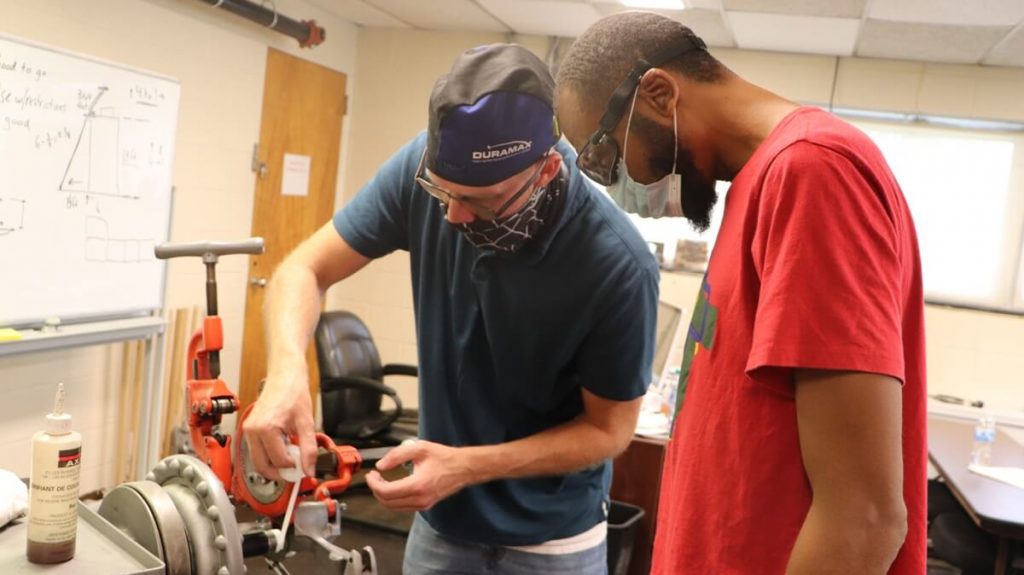Predictions say that the demand for pipefitters will rise by 16% from 2020 to 2030. This is substantially faster than the overall average for all occupations. Instead, new buildings and the need to maintain and repair plumbing systems in existing flats will drive demand for pipefitters.
Apart from that, about 50,000 opportunities for plumbers and pipefitters are proposed each year over the decade. Most of those openings are the result of replacing workers who transfer to different occupations.
Pipefitter and plumber are usually confused with each other. But they are different trades with different sets of roles and responsibilities. Hence, if you want to become a plumber or a pipefitter, it’s good to know that these two jobs are separate.
Pipefitters are more focused on furnishing specialized pipes to deal with pressurized substances. However, plumbers typically examine more common residential services like bathrooms and drains. Pipefitters typically work with probable hazardous substances in a more specialized, automated context.
The demand for pipefitters has always been huge. Plumbers and pipefitters operated about 480,600 jobs in 2018. These technicians work in factories, businesses, homes, and other areas where pipes or septic systems are used.
Nevertheless, plumbers and fitters lift heavy materials, climb ladders, and operate in tight spaces. Some pipefitters travel to numerous worksites every day.
Pipefitters and plumbers have one of the most severe damages and illnesses of all trades. Injuries from sharp tools, burn from hot pipes and soldering devices, and falls from ladders are typical injuries.
Most utmost pipefitters and plumbers work full time, which includes nights and weekends. They are often on call to manage emergencies. Self-employed tradespeople may be able to set up their programs.
For well-defined careers, most pipefitters and plumbers learn on the job through an apprenticeship. Some start by visiting a technical school. In addition, most countries and regions require plumbers to be licensed.
Indeed, a high school diploma or equivalent is typically wanted to become a plumber. Therefore, plumbing trade schools offer classes on pipe system design, tool use, and safety. Moreover, some schools provide welding education that is considered essential by some pipefitter training programs.
Notwithstanding, most plumbers and pipefitters learn their occupation through a 4- or 5-year apprenticeship. Trainees typically get 2,000 hours of paid on-the-job plumbing training and some classroom education each year. In the classroom, students learn safety, blueprint reading, and local plumbing codes and regulations.
Besides, they also study mathematics, applied physics, and chemistry. Unions and corporations offer apprenticeship programs. However, most pipefitters enter pipefitting classes directly.
The Philadelphia Technician Training Institute offers a pre-apprenticeship training program in plumbing and other trades. Nonetheless, after completing an apprenticeship program, plumbers and pipefitters are recognized as journey workers, which helps them perform duties by themselves.
.Tradespeople with several years of plumbing expertise may earn master status by passing an exam. In addition, some states need a business to operate a master plumber to get a plumbing contractor’s license.
Many countries and areas need plumbers to be licensed. Indeed, some states will need plumbers to have at least two to five years of relevant work experience. Furthermore, most companies require to opt for plumbing certificate programs to have a license.
Indeed, some states require pipefitters to be licensed. They may even ask for a special license to work on gas lines. Licensing typically needs an exam, work experience, or both.

Communication Skills.
Pipefitters must be capable of directing workers, bid on jobs, and project work plans. Additionally, plumbers talk to customers constantly and need to recognize and communicate queries and directions. The demand for pipefitters with good communication skills is enormous.
Dexterity.
Pipefitters must be able to design parts and instruments precisely, often in tight places.
Mechanical Skills.
Pipefitters and steamfitters use a variation of tools to gather and repair pipe systems. Therefore, finding the right tool and installing, repairing, or maintaining a plan is crucial to their work.
Physical Strength.
Pipefitters and Plumbers must be strong enough to raise and move heavy tools and machines.
Troubleshooting Skills.
Plumbers and pipefitters diagnose and fix problems. For instance, pipefitters must be capable of performing load tests to pinpoint the area of a leak.
If you want to get a plumbing apprenticeship, you need to opt for the plumbing training program. After this, the number of job seekers will likely match the number of job openings.
Besides, pipefitting and plumbing are well-defined careers and will grow by 15% from 2020 to 2040. In addition, our students who pursued Steam, Sprinkler, and Pipefitting programs are currently earning ample money. The counties in which they are working include upper North Philadelphia, South Philadelphia east, South Philadelphia West, Southwest Philadelphia.
Hence, now it’s the most suitable time to start your plumbing course with the accurate trade schools plumbing. Plus, PTTI is one of the esteemed institutes for each tradesperson because of its quality education. Therefore, you must schedule your classes with us as soon as possible.
Read More:
Discover pipefitting possibilities at PTTI.Discover Program

Discover Endless Possibilities with pipefitting program at PTTI.
